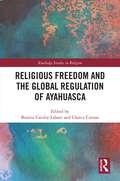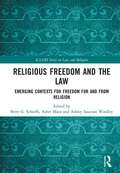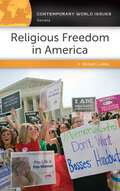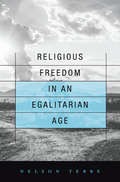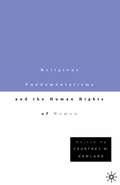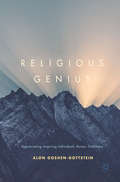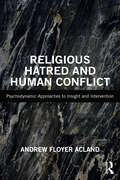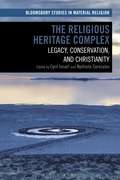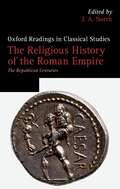- Table View
- List View
Religious Freedom and the Constitution
by Christopher L. Eisgruber Lawrence G. SagerReligion has become a charged token in a politics of division. In disputes about faith-based social services, public money for religious schools, the Pledge of Allegiance, Ten Commandments monuments, the theory of evolution, and many other topics, angry contestation threatens to displace America's historic commitment to religious freedom. Part of the problem, the authors argue, is that constitutional analysis of religious freedom has been hobbled by the idea of "a wall of separation" between church and state. That metaphor has been understood to demand that religion be treated far better than other concerns in some contexts, and far worse in others. Sometimes it seems to insist on both contrary forms of treatment simultaneously. Missing has been concern for the fair and equal treatment of religion. In response, the authors offer an understanding of religious freedom called Equal Liberty. Equal Liberty is guided by two principles. First, no one within the reach of the Constitution ought to be devalued on account of the spiritual foundation of their commitments. Second, all persons should enjoy broad rights of free speech, personal autonomy, associative freedom, and private property. Together, these principles are generous and fair to a wide range of religious beliefs and practices. With Equal Liberty as their guide, the authors offer practical, moderate, and appealing terms for the settlement of many hot-button issues that have plunged religious freedom into controversy. Their book calls Americans back to the project of finding fair terms of cooperation for a religiously diverse people, and it offers a valuable set of tools for working toward that end.
Religious Freedom and the Global Regulation of Ayahuasca (Routledge Studies in Religion)
by Beatriz Caiuby Labate Clancy CavnarThis book offers a comprehensive view of the legal, political, and ethical challenges related to the global regulation of ayahuasca, bringing together an international and interdisciplinary group of scholars. Ayahuasca is a psychoactive brew containing DMT, which is a Schedule I substance under the United Nations Convention on Psychotropic Substances, and the legality of its ritual use has been interpreted differently throughout the world. The chapters in this volume reflect on the complex implications of the international expansion of ayahuasca, from health, spirituality, and human rights impacts on individuals, to legal and policy impacts on national governments. While freedom of religion is generally protected, this protection depends on the recognition of a religion’s legitimacy, and whether particular practices may be deemed a threat to public health, safety or morality. Through acomparative analysis of different contexts in North America, South America and Europe in which ayahuasca is consumed, the book investigates the conceptual, philosophical, and legal distinctions among the fields of shamanism, religion, and medicine. It will be particularly relevant to scholars with an interest in Indigenous religion and in religion and law.
Religious Freedom and the Global Regulation of Ayahuasca (Routledge Studies in Religion)
by Beatriz Caiuby Labate Clancy CavnarThis book offers a comprehensive view of the legal, political, and ethical challenges related to the global regulation of ayahuasca, bringing together an international and interdisciplinary group of scholars. Ayahuasca is a psychoactive brew containing DMT, which is a Schedule I substance under the United Nations Convention on Psychotropic Substances, and the legality of its ritual use has been interpreted differently throughout the world. The chapters in this volume reflect on the complex implications of the international expansion of ayahuasca, from health, spirituality, and human rights impacts on individuals, to legal and policy impacts on national governments. While freedom of religion is generally protected, this protection depends on the recognition of a religion’s legitimacy, and whether particular practices may be deemed a threat to public health, safety or morality. Through acomparative analysis of different contexts in North America, South America and Europe in which ayahuasca is consumed, the book investigates the conceptual, philosophical, and legal distinctions among the fields of shamanism, religion, and medicine. It will be particularly relevant to scholars with an interest in Indigenous religion and in religion and law.
Religious Freedom and the Law: Emerging Contexts for Freedom for and from Religion (ICLARS Series on Law and Religion)
by Brett G. Scharffs Asher Maoz Ashley Isaacson WoolleyThis volume presents a timely analysis of some of the current controversies relating to freedom for religion and freedom from religion that have dominated headlines worldwide. The collection trains the lens closely on select issues and contexts to provide detailed snapshots of the ways in which freedom for and from religion are conceptualized, protected, neglected, and negotiated in diverse situations and locations. A broad range of issues including migration, education, the public space, prisons and healthcare are discussed drawing examples from Europe, the US, Asia, Africa and South America. Including contributions from leading experts in the field, the book will be essential reading for researchers and policy-makers interested in Law and Religion.
Religious Freedom and the Law: Emerging Contexts for Freedom for and from Religion (ICLARS Series on Law and Religion)
by Brett G. Scharffs Asher Maoz Ashley Isaacson WoolleyThis volume presents a timely analysis of some of the current controversies relating to freedom for religion and freedom from religion that have dominated headlines worldwide. The collection trains the lens closely on select issues and contexts to provide detailed snapshots of the ways in which freedom for and from religion are conceptualized, protected, neglected, and negotiated in diverse situations and locations. A broad range of issues including migration, education, the public space, prisons and healthcare are discussed drawing examples from Europe, the US, Asia, Africa and South America. Including contributions from leading experts in the field, the book will be essential reading for researchers and policy-makers interested in Law and Religion.
Religious Freedom at Risk: The EU, French Schools, and Why the Veil was Banned (Muslims in Global Societies Series #8)
by Melanie AdrianThis book examines matters of religious freedom in Europe, considers the work of the European Court of Human Rights in this area, explores issues of multiculturalism and secularism in France, of women in Islam, and of Muslims in the West. The work presents legal analysis and ethnographic fieldwork, focusing on concepts such as laïcité, submission, equality and the role of the state in public education, amongst others. Through this book, the reader can visit inside a French public school located in a low-income neighborhood just south of Paris and learn about the complex dynamics that led up to the passing of the 2004 law banning Muslim headscarves. The chapters bring to light the actors and cultures within the school that set the stage for the passing of the law and the political philosophy that supports it. School culture and philosophy are compared and contrasted to the thoughts and opinions of the teachers, administrators and students to gage how religious freedom and identity are understood. The book goes on to explore the issue of religious freedom at the European Court of Human Rights. The author argues that the right to religious freedom has been too narrowly understood and is being fenced in by static visions of Islam. This jeopardizes the idea of religious freedom more broadly. By becoming entangled with regional and domestic politics, the Court is neglecting important nuances and is jeopardizing secularism, pluralism and democracy. This is a highly readable and accessible book that will appeal to students and scholars of law, anthropology, religious studies and philosophy of religion. 内容紹介 この本はヨーロッパにおける宗教の自由に関する問題を考察したもので、欧州人権裁 判所のそれに関する取り組みと、フランスにおける多文化主義、世俗主義、イスラム女 性、西洋におけるイスラム教の問題について調査している。その成果として、法的分析 、例えば政教分離などの概念に注目した民俗学的実地調査、提案、とりわけ公教育にお ける国家の公平性と役割に注目し、それを示している。この本を通して、読者はフラン スのパリ南部の低所得地域にある公立学校の内部事情を知ることができる。そしてイス ラム教徒が頭にスカーフをかぶることを禁じた2004年制定の法律が可決されるに至った 複雑な作用について学ぶことができる。各章では、法案成立のお膳立てをしてきた学校 関係者とその文化、そしてそれを支えた政治哲学について明らかにしている。宗教の自 由と独自性が人々にどのくらい理解されているかを計るために、学校文化と哲学を、教 員や管理職、学生の考えや意見と比較対比している。この本ではさらに欧州人権裁判所 における宗教の自由に関する問題を探求している。宗教の自由に関する権利は十分に理 解されておらず、人々はイスラム教についての固定的な見方から抜け出せないため、そ れが宗教の自由という考えを露骨に危険にさらしている。そして、宗教と国内政治のも つれによって、裁判所は微妙だが重要な差違を軽視し、それにより、世俗主義、多元主 義、民主主義が危険にさらされていると著者は述べている。この本は大変読みやすくわ かりやすいため、法律、人類学、宗教学、宗教哲学を学ぶ学生や研究者にお勧めしたい 本である。
Religious Freedom in America: A Reference Handbook (Contemporary World Issues)
by Michael C. LeMayThis book provides the answers to controversial questions about religious liberties in the United States and connected issues through balanced, thorough, and nonjudgmental coverage of the issues in a reference format.The subject of religious freedom is important to all American citizens, regardless of religious affiliation or ethnicity. Are the rights of religious individuals being eroded, or is religion being unfairly used to deny basic secular rights to individuals? How will religious institutions adapt to changes in legislation that have an impact on how they operate? Does the Supreme Court have the right to enforce these changes? Finally, how can the precarious separation of church and state be maintained while simultaneously respecting both institutions?This single-volume work provides an introduction that addresses the historical background of religious freedom in America, accurately explains the latest legal developments in religious freedom in the United States, and presents an unbiased account of the probable impact of the new Freedom of Religion laws in the continuing culture war. Readers will gain insight into key controversies such as prayer in public schools, creationism versus evolution, abortion, religious objections to medical care, religious displays in public places, same-sex marriage and LGBT rights, and state and federal religious freedom acts. The book also includes perspective essays by outside contributors, a selection of useful primary documents, a listing of print and nonprint resources, a chronology, and a glossary of terms.
Religious Freedom in America: A Reference Handbook (Contemporary World Issues)
by Michael C. LeMayThis book provides the answers to controversial questions about religious liberties in the United States and connected issues through balanced, thorough, and nonjudgmental coverage of the issues in a reference format.The subject of religious freedom is important to all American citizens, regardless of religious affiliation or ethnicity. Are the rights of religious individuals being eroded, or is religion being unfairly used to deny basic secular rights to individuals? How will religious institutions adapt to changes in legislation that have an impact on how they operate? Does the Supreme Court have the right to enforce these changes? Finally, how can the precarious separation of church and state be maintained while simultaneously respecting both institutions?This single-volume work provides an introduction that addresses the historical background of religious freedom in America, accurately explains the latest legal developments in religious freedom in the United States, and presents an unbiased account of the probable impact of the new Freedom of Religion laws in the continuing culture war. Readers will gain insight into key controversies such as prayer in public schools, creationism versus evolution, abortion, religious objections to medical care, religious displays in public places, same-sex marriage and LGBT rights, and state and federal religious freedom acts. The book also includes perspective essays by outside contributors, a selection of useful primary documents, a listing of print and nonprint resources, a chronology, and a glossary of terms.
Religious Freedom in an Egalitarian Age
by Nelson TebbeNelson Tebbe shows how a method called social coherence offers a way to resolve conflicts between advocates of religious freedom and proponents of equality law. Based on the way people reason through moral problems in everyday life, it can lead to workable solutions in a wide range of issues, including gay rights and women’s reproductive choice.
Religious Freedom in Islam: The Fate of a Universal Human Right in the Muslim World Today
by Daniel PhilpottSince at least the attacks of September 11, 2001, one of the most pressing political questions of the age has been whether Islam is hostile to religious freedom. Daniel Philpott examines conditions on the ground in forty-seven Muslim-majority countries today and offers an honest, clear-eyed answer to this urgent question. It is not, however, a simple answer. From a satellite view, the Muslim world looks unfree. But, Philpott shows, the truth is much more complex. Some one-fourth of Muslim-majority countries are in fact religiously free. Of the other countries, about forty percent are governed not by Islamists but by a hostile secularism imported from the West, while the other sixty percent are Islamist. The picture that emerges is both honest and hopeful. Yes, most Muslim-majority countries are lacking in religious freedom. But, Philpott argues, the Islamic tradition carries within it "seeds of freedom," and he offers guidance for how to cultivate those seeds in order to expand religious freedom in the Muslim world and the world at large. It is an urgent project. Religious freedom promotes goods like democracy and the advancement of women that are lacking in the Muslim-majority world and reduces ills like civil war, terrorism, and violence. Further, religious freedom is simply a matter of justice--not an exclusively Western value, but rather a universal right rooted in human nature. Its realization is critical to the aspirations of religious minorities and dissenters in Muslim countries, to Muslims living in non-Muslim countries or under secular dictatorships, and to relations between the West and the Muslim world. In this thoughtful book, Philpott seeks to establish a constructive middle ground in a fiery and long-lasting debate over Islam.
RELIGIOUS FREEDOM IN ISLAM C: The Fate of a Universal Human Right in the Muslim World Today
by Daniel PhilpottSince at least the attacks of September 11, 2001, one of the most pressing political questions of the age has been whether Islam is hostile to religious freedom. Daniel Philpott examines conditions on the ground in forty-seven Muslim-majority countries today and offers an honest, clear-eyed answer to this urgent question. It is not, however, a simple answer. From a satellite view, the Muslim world looks unfree. But, Philpott shows, the truth is much more complex. Some one-fourth of Muslim-majority countries are in fact religiously free. Of the other countries, about forty percent are governed not by Islamists but by a hostile secularism imported from the West, while the other sixty percent are Islamist. The picture that emerges is both honest and hopeful. Yes, most Muslim-majority countries are lacking in religious freedom. But, Philpott argues, the Islamic tradition carries within it "seeds of freedom," and he offers guidance for how to cultivate those seeds in order to expand religious freedom in the Muslim world and the world at large. It is an urgent project. Religious freedom promotes goods like democracy and the advancement of women that are lacking in the Muslim-majority world and reduces ills like civil war, terrorism, and violence. Further, religious freedom is simply a matter of justice--not an exclusively Western value, but rather a universal right rooted in human nature. Its realization is critical to the aspirations of religious minorities and dissenters in Muslim countries, to Muslims living in non-Muslim countries or under secular dictatorships, and to relations between the West and the Muslim world. In this thoughtful book, Philpott seeks to establish a constructive middle ground in a fiery and long-lasting debate over Islam.
Religious Fundamentalism in Developing Countries (Contributions to the Study of Religion)
by Santosh C. Saha Thomas K. CarrUsing a variety of methodological approaches, this timely book offers a thorough examination of the impact and implications of religious fundamentalism in developing nations. The authors explore why and how adherence to fundamentalist principles affects the social, political, and religious development of such countries as Israel, India, Pakistan, Bangladesh, Egypt, and the Philippines. One of the most significant contributions of this volume is that it challenges the assumption that fundamentalism in developing countries is based solely on religious motivations.The authors maintain that fundamentalism of this sort is motivated by both religious and political convictions. This combination of religious and political motivations allows fundamentalism to exert a tremendous influence on the public policies of these developing nations. As the social fabric of such countries continues to be developed, it is clear that fundamentalism will continue to play a significant and potentially dangerous role.
Religious Fundamentalism in the Age of Pandemic (Religionswissenschaft #21)
by Nina KäsehageThe multidisciplinary anthology Religious Fundamentalism in the Age of Pandemic provides deep insights concerning the current impact of Covid-19 on various religious groups and believers around the world. Based on contributions of well-known scholars in the field of Religious Fundamentalism, the contributors offer about a window into the origins of religious fundamentalism and the development of these movements as well as the creation of the category itself. Further recommendations regarding specific (fundamentalist) religious groups and actors and their possible development within Buddhism, Christianity, Islam and Judaism round up the discussion about the rise of Religious Fundamentalism in the Age of Pandemic.
Religious Fundamentalisms and the Human Rights of Women
by Courtney W. HowlandDialogue on the conflict between religious fundamentalism and women's rights is often stymied by an 'all or nothing' approach: fundamentalists claim of absolute religious freedom, while some feminists dismiss religion entirely as being so imbued with patriarchy as to be eternally opposed to women's rights. This ignores, though, the experiences of religious women who suffer under fundamentalism and fight to resist it, perceiving themselves to be at once religious and feminist. In Religious Fundamentalisms and the Human Rights of Women , Howland provides a forum for these different scholars, both religious and nonreligious, to meet and seek common ground in their fight against fundamentalism. Through an examination of international human rights, national law, grass roots activism, and theology, this volume explores the acute problems that contemporary fundamentalist movements pose for women's equality and liberty rights.
Religious Genius: Appreciating Inspiring Individuals Across Traditions
by Alon Goshen-GottsteinThis book sets forth a new area in the study of extraordinary individuals in religious traditions. It develops the category of “Religious Genius” as an alternative to existing categories, primarily “saint.” It constructs a model by which to appreciate these individuals, suggesting key characteristics such as love, humility, and self-surrender. Religious geniuses transform their traditions and their legacies endure through these very transformations. They also inspire changes across religious boundaries and traditions. The study of religious geniuses in various faith traditions therefore advances interfaith engagement today. The book complements existing, primarily historical, studies of saints by offering a phenomenological approach that seeks to touch the subjectivity of these individuals, and how they have affected the unfolding of their religious traditions.
Religious Genius: Appreciating Inspiring Individuals Across Traditions
by Alon Goshen-GottsteinThis book sets forth a new area in the study of extraordinary individuals in religious traditions. It develops the category of “Religious Genius” as an alternative to existing categories, primarily “saint.” It constructs a model by which to appreciate these individuals, suggesting key characteristics such as love, humility, and self-surrender. Religious geniuses transform their traditions and their legacies endure through these very transformations. They also inspire changes across religious boundaries and traditions. The study of religious geniuses in various faith traditions therefore advances interfaith engagement today. The book complements existing, primarily historical, studies of saints by offering a phenomenological approach that seeks to touch the subjectivity of these individuals, and how they have affected the unfolding of their religious traditions.
Religious Hair Display and Its Meanings (Popular Culture, Religion and Society. A Social-Scientific Approach #4)
by William C. Innes, JrThis book explores the fascinating world of religious hair observances within six religious traditions that account for 77% of the world’s adherents: Judaism, Christianity, Islam, Hinduism, Buddhism, and Sikhism. Symbolic use of hair has been, and remains, prevalent in all six and carries significant amounts of religious and social meaning. Hair is a unique body substance. It can be shaped and colored, removed from us without pain but still retain an individual’s essence, signal our age, sex, and sexual maturity, and much, much more. The book’s approach is to situate each practice within its tradition. That requires a study of its foundational leaders and their teachings, sacred texts (where they mention hair), its rites and rituals, ideas of religious power and subsequent historical development. Contemporary practitioners are interviewed for their motivations. Even more insight can be gleaned by searching beyond an overt religious purpose. Social scientists from anthropology, sociology, psychology, and related fields bring their research to deliver added perceptions.The author reveals how hair practices are created from ancient psychological and cultural impulses, become modified by time, culture and religious intent, and are adopted by adherents for reasons ranging from personal religious expression to group identity. This book is written for the interested observer of our increasingly diverse society and for the student of comparative religion and sociology. It will change forever how you see hair.
Religious Hatred: Prejudice, Islamophobia and Antisemitism in Global Context
by Paul HedgesWhy does religion inspire hatred? Why do people in one religion sometimes hate people of another religion, and also why do some religions inspire hatred from others?This book shows how scholarly studies of prejudice, identity formation, and genocide studies can shed light on global examples of religious hatred. The book is divided into four parts, focusing respectively on: theories of prejudice and violence; historical developments of Antisemitism, Islamophobia, and race; contemporary Western Antisemitism and Islamophobia; and, prejudices beyond the West in the Islamic, Buddhist, and Hindu traditions. Each part ends with a special focus section. Key features include: - A compelling synthesis of theories of prejudice, identity, and hatred to explain Islamophobia and Antisemitism. - An innovative theory of human violence and genocide which explains the link to prejudice. - Case studies of both Western Antisemitism and Islamophobia in history and today, alongside global studies of Islamic Antisemitism and Hindu and Buddhist Islamophobia - Integrates discussion of race and racialisation as aspects of Islamophobic and Antisemitic prejudice in relation to their framing in religious discourses. - Accessible for general readers and students, it can be employed as a textbook for students or read with benefit by scholars for its novel synthesis and theories.The book focuses on Antisemitism and Islamophobia, both in the West and beyond, including examples of prejudices and hatred in the Islamic, Hindu, and Buddhist traditions. Drawing on examples from Europe, North America, MENA, South and Southeast Asia, and Africa, Paul Hedges points to common patterns, while identifying the specifics of local context.Religious Hatred is an essential guide for understanding the historical origins of religious hatred, the manifestations of this hatred across diverse religious and cultural contexts, and the strategies employed by activists and peacemakers to overcome this hatred.
Religious Hatred: Prejudice, Islamophobia and Antisemitism in Global Context
by Paul HedgesWhy does religion inspire hatred? Why do people in one religion sometimes hate people of another religion, and also why do some religions inspire hatred from others?This book shows how scholarly studies of prejudice, identity formation, and genocide studies can shed light on global examples of religious hatred. The book is divided into four parts, focusing respectively on: theories of prejudice and violence; historical developments of Antisemitism, Islamophobia, and race; contemporary Western Antisemitism and Islamophobia; and, prejudices beyond the West in the Islamic, Buddhist, and Hindu traditions. Each part ends with a special focus section. Key features include: - A compelling synthesis of theories of prejudice, identity, and hatred to explain Islamophobia and Antisemitism. - An innovative theory of human violence and genocide which explains the link to prejudice. - Case studies of both Western Antisemitism and Islamophobia in history and today, alongside global studies of Islamic Antisemitism and Hindu and Buddhist Islamophobia - Integrates discussion of race and racialisation as aspects of Islamophobic and Antisemitic prejudice in relation to their framing in religious discourses. - Accessible for general readers and students, it can be employed as a textbook for students or read with benefit by scholars for its novel synthesis and theories.The book focuses on Antisemitism and Islamophobia, both in the West and beyond, including examples of prejudices and hatred in the Islamic, Hindu, and Buddhist traditions. Drawing on examples from Europe, North America, MENA, South and Southeast Asia, and Africa, Paul Hedges points to common patterns, while identifying the specifics of local context.Religious Hatred is an essential guide for understanding the historical origins of religious hatred, the manifestations of this hatred across diverse religious and cultural contexts, and the strategies employed by activists and peacemakers to overcome this hatred.
Religious Hatred and Human Conflict: Psychodynamic Approaches to Insight and Intervention
by Andrew Floyer AclandReligious Hatred and Human Conflict focuses the lens of psychodynamic psychology on a phenomenon that often confounds conventional thinking – the intensity of conflict with religious or quasi-religious dimensions. The book highlights six dimensions of religion: identity, doctrine and practice, emotion and experience, mythology, sacred values and power and control, exploring how these can give rise to religious hatred and lead to marginalisation, persecution and even genocide. It also explores reasons for the evolution of religion and religious hatred, and their relationship with human behaviour through contemporary issues such as fundamentalism, martyrdom, clerical narcissism and apocalyptic belief. Acland examines how religious hatred and conflict may be transcended by facilitating processes of dialogue and diapraxis which enable a systematic understanding of prejudices and projections. Last, it offers practical methods and strategies for helping individuals and communities grow beyond the constraints of religious hatred, treating religious hatred as a psycho-spiritual problem that requires self-understanding. Identifying the implications for professionals in conflict resolution and mediation, politicians, community leaders, diplomats and anyone working to prevent or reduce conflict where religious belief is a factor, this book sets out how those tasked with intervening can respond to the challenges involved. It will also be highly relevant reading for students and researchers of psychology and religious studies.
Religious Hatred and Human Conflict: Psychodynamic Approaches to Insight and Intervention
by Andrew Floyer AclandReligious Hatred and Human Conflict focuses the lens of psychodynamic psychology on a phenomenon that often confounds conventional thinking – the intensity of conflict with religious or quasi-religious dimensions. The book highlights six dimensions of religion: identity, doctrine and practice, emotion and experience, mythology, sacred values and power and control, exploring how these can give rise to religious hatred and lead to marginalisation, persecution and even genocide. It also explores reasons for the evolution of religion and religious hatred, and their relationship with human behaviour through contemporary issues such as fundamentalism, martyrdom, clerical narcissism and apocalyptic belief. Acland examines how religious hatred and conflict may be transcended by facilitating processes of dialogue and diapraxis which enable a systematic understanding of prejudices and projections. Last, it offers practical methods and strategies for helping individuals and communities grow beyond the constraints of religious hatred, treating religious hatred as a psycho-spiritual problem that requires self-understanding. Identifying the implications for professionals in conflict resolution and mediation, politicians, community leaders, diplomats and anyone working to prevent or reduce conflict where religious belief is a factor, this book sets out how those tasked with intervening can respond to the challenges involved. It will also be highly relevant reading for students and researchers of psychology and religious studies.
The Religious Heritage Complex: Legacy, Conservation, and Christianity (Bloomsbury Studies in Material Religion)
by Cyril Isnart Nathalie CerezalesThe Religious Heritage Complex examines religious institutions and heritage-making, arguing that the relationship between the two is not as clear-cut as some might think. In fact, the authors show that religious activity has always combined care for the past with conscious practices of heritage-making, which they term “the religious heritage complex.”The book considers the ways patrimony, religion, and identity interact in different contexts worldwide and how religious objects and sites function as identity. It focuses on heritage-making as a religious and material activity for the groups in charge of a religious inheritance, and considers heritage activities as a form of spiritual renewal and transmission. Case studies explore Christian, Afro-Brazilian, Muslim, and Buddhist traditions located in Europe, the Americas, Africa, and Asia. By investigating the longstanding and tightly-enmeshed connections that weave together religion and cultural heritage, this book allows us to think through the ambiguity of religious heritage.
The Religious Heritage Complex: Legacy, Conservation, and Christianity (Bloomsbury Studies in Material Religion)
The Religious Heritage Complex examines religious institutions and heritage-making, arguing that the relationship between the two is not as clear-cut as some might think. In fact, the authors show that religious activity has always combined care for the past with conscious practices of heritage-making, which they term “the religious heritage complex.”The book considers the ways patrimony, religion, and identity interact in different contexts worldwide and how religious objects and sites function as identity. It focuses on heritage-making as a religious and material activity for the groups in charge of a religious inheritance, and considers heritage activities as a form of spiritual renewal and transmission. Case studies explore Christian, Afro-Brazilian, Muslim, and Buddhist traditions located in Europe, the Americas, Africa, and Asia. By investigating the longstanding and tightly-enmeshed connections that weave together religion and cultural heritage, this book allows us to think through the ambiguity of religious heritage.
The Religious History of the Roman Empire: The Republican Centuries (Oxford Readings in Classical Studies)
by J. A. NorthThe Religious History of the Roman Empire: The Republican Centuries is the second Oxford Readings in Classical Studies volume on the religious history of the Roman Empire, accompanying the volume on paganism, Judaism, and Christianity. This volume presents fourteen chapters dealing with aspects of the religious life of Republican Rome between c. 500 BCE and the fall of the Republican constitution in c. 30 BCE. The topics covered include Iron Age rituals (Christopher Smith); Roman Priesthood (John Scheid; Mary Beard); religion and war (Jörg Rüpke); religious behaviour in the context of polytheism (Andreas Bendlin); religious ritual in early and middle Republic (John North); Italian warfare practices (Olivier de Cazanove); the role of women (Rebecca Flemming); sacrificial ritual in Roman poetry (Denis Feeney); the centuriation-ritual (Daniel Gargola); Roman divination (Mary Beard); Augustan Peace and the stars (Alfred Schmid); the great cult-places of Italy (John Scheid); the grove of Pesaro (Filippo Coarelli). Originally published between 1981 and 2011, these chapters provide a vivid picture of key issues under discussion in this period, providing a missing link in the historiography of Roman republican religion. A central question concerns the balance to be found between ritual and belief, both problematic concepts in interpreting this religious tradition. While there can be no question that the performance of rituals was a regular traditional activity to which Romans attached great significance, particularly those who were in a responsible position as priests or senators, the later years of the Republic increasingly saw religious issues taken as matters for debate, and books on religious themes, unknown before the age of Cicero and Varro, began to appear.
The Religious History of the Roman Empire: The Republican Centuries (Oxford Readings in Classical Studies)
The Religious History of the Roman Empire: The Republican Centuries is the second Oxford Readings in Classical Studies volume on the religious history of the Roman Empire, accompanying the volume on paganism, Judaism, and Christianity. This volume presents fourteen chapters dealing with aspects of the religious life of Republican Rome between c. 500 BCE and the fall of the Republican constitution in c. 30 BCE. The topics covered include Iron Age rituals (Christopher Smith); Roman Priesthood (John Scheid; Mary Beard); religion and war (Jörg Rüpke); religious behaviour in the context of polytheism (Andreas Bendlin); religious ritual in early and middle Republic (John North); Italian warfare practices (Olivier de Cazanove); the role of women (Rebecca Flemming); sacrificial ritual in Roman poetry (Denis Feeney); the centuriation-ritual (Daniel Gargola); Roman divination (Mary Beard); Augustan Peace and the stars (Alfred Schmid); the great cult-places of Italy (John Scheid); the grove of Pesaro (Filippo Coarelli). Originally published between 1981 and 2011, these chapters provide a vivid picture of key issues under discussion in this period, providing a missing link in the historiography of Roman republican religion. A central question concerns the balance to be found between ritual and belief, both problematic concepts in interpreting this religious tradition. While there can be no question that the performance of rituals was a regular traditional activity to which Romans attached great significance, particularly those who were in a responsible position as priests or senators, the later years of the Republic increasingly saw religious issues taken as matters for debate, and books on religious themes, unknown before the age of Cicero and Varro, began to appear.

